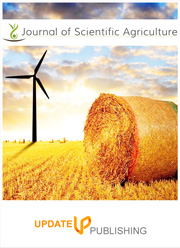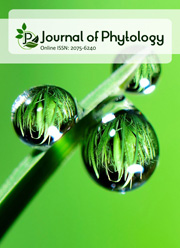Iron uptake in spinach (Spinacia oleracea) using biochar-iron complex derived from sugarcane bagasse under greenhouse conditions
DOI:
https://doi.org/10.25081/jsa.2025.v9.9672Keywords:
Biochar, Green house, Iron Complexation, Iron uptake, SpinachAbstract
Iron deficiency limits spinach (Spinacia oleracea) growth and nutritional quality, particularly in alkaline soils. By investigating the complexation of iron with sugarcane bagasse-derived biochar, this study aimed to bridge that gap and offer insights into an innovative approach for improving iron nutrition in spinach crops. This study also evaluated the efficacy of sugarcane bagasse-derived biochar-iron complexes in enhancing iron uptake under controlled greenhouse conditions. Biochar-iron complexes were synthesized via pyrolysis and treated with iron (FeCl3) at 0.25 M, 0.50 M, and 0.75 M. In the greenhouse, using a Randomized Complete Design (RCD), the experiment compared treatments including FeCl3 only, biochar only and biochar-iron complexes at 0.25 M, 0.50 M, and 0.75 M concentrations against an untreated control. Iron uptake in spinach leaves was measured over three months using Atomic Absorption Spectroscopy (AAS). Infrared Fourier Transform Spectroscopy (FT-IR) analysis confirmed key functional groups involved in biochar-iron chelation, while X-Ray Fluorescence (XRF) revealed increased iron loading, peaking at 0.75 M. Analysis of variance from the greenhouse study revealed significant effects of treatment, time, and their interaction (p<0.001). Although the 0.75 M treatment produced the highest iron content (220 to 300 ppm), the 0.50 M biochar-iron complex is considered optimal, as it achieved iron levels within the FAO guideline range (80-250 ppm). In contrast, conventional FeCl3 treatment-maintained leaf iron at only 1.7-1.9 ppm throughout the three months, reflecting poor soil retention and rapid leaching of FeCl3. These findings highlight the composite’s superior magnitude and temporal stability of iron delivery. Sugarcane bagasse biochar–iron composite thus emerges as a promising, eco-friendly alternative to synthetic iron fertilizers for improving soil fertility and crop nutrition, addressing iron deficiency in sustainable food production.
Downloads
References
Ahmad, M., Rajapaksha, A. U., Lim, J. E., Zhang, M., Bolan, N., Mohan, D., Vithanage, M., Lee, S. S., & Ok, Y. S. (2014). Biochar as a sorbent for contaminant management in soil and water: A review. Chemosphere, 99, 19-33. https://doi.org/10.1016/j.chemosphere.2013.10.071
Baigorri, R., San Francisco, S., Urrutia, Ó., & García-Mina, J. M. (2020). Biochar-Ca and biochar-Al/-Fe-mediated phosphate exchange capacity are main drivers of the different biochar effects on plants in acidic and alkaline soils. Agronomy, 10(7), 968. https://doi.org/10.3390/agronomy10070968
Bhat, M. A., Mishra, A. K., Shah, S. N., Bhat, M. A., Jan, S., Rahman, S., Baek, K.-H., & Jan, A. T. (2024). Soil and mineral nutrients in plant health: A prospective study of iron and phosphorus in the growth and development of plants. Current Issues in Molecular Biology, 46(6), 5194-5222. https://doi.org/10.3390/cimb46060312
Bonvin, D., Bastiaansen, J. A. M., Stuber, M., Hofmann, H., & Mionić Ebersold, M. (2017). Chelating agents as coating molecules for iron oxide nanoparticles. RSC Advances, 7(88), 55598-55609. https://doi.org/10.1039/C7RA08217G
Carter, S., Shackley, S., Sohi, S., Suy, T., & Haefele, S. (2013). The Impact of Biochar Application on Soil Properties and Plant Growth of Pot Grown Lettuce (Lactuca sativa) and Cabbage (Brassica chinensis). Agronomy, 3(2), 404-418. https://doi.org/10.3390/agronomy3020404
Dey, S., Purakayastha, T. J., Sarkar, B., Rinklebe, J., Kumar, S., Chakraborty, R., Datta, A., Lal, K., & Shivay, Y. S. (2023). Enhancing cation and anion exchange capacity of rice straw biochar by chemical modification for increased plant nutrient retention. Science of the Total Environment, 886, 163681. https://doi.org/10.1016/j.scitotenv.2023.163681
Fan, M., Li, C., Sun, Y., Zhang, L., Zhang, S., & Hu, X. (2021). In situ characterization of functional groups of biochar in pyrolysis of cellulose. Science of the Total Environment, 799, 149354. https://doi.org/10.1016/j.scitotenv.2021.149354
Huang, Y., Chen, Y., Wen, D., Zhao, P., Li, F., Li, L., Du, R., Shi, H., Deng, T., & Du, Y. (2022). Biochar-based molybdenum slow-release fertilizer enhances nitrogen assimilation in Chinese flowering cabbage (Brassica parachinensis). Chemosphere, 303, 134663. https://doi.org/10.1016/j.chemosphere.2022.134663
Joseph, S., Cowie, A. L., Van Zwieten, L., Bolan, N., Budai, A., Buss, W., Cayuela, M. L., Graber, E. R., Ippolito, J. A., Kuzyakov, Y., Luo, Y., Ok, Y. S., Palansooriya, K. N., Shepherd, J., Stephens, S., Weng, Z. (Han), & Lehmann, J. (2021). How biochar works, and when it doesn’t: A review of mechanisms controlling soil and plant responses to biochar. GCB Bioenergy, 13(11), 1731-1764. https://doi.org/10.1111/gcbb.12885
Kappler, A., Bryce, C., Mansor, M., Lueder, U., Byrne, J. M., & Swanner, E. D. (2021). An evolving view on biogeochemical cycling of iron. Nature Reviews Microbiology, 19(6), 360-374. https://doi.org/10.1038/s41579-020-00502-7
Kuang, P., Cui, Y., Zhang, Z., Ma, K., Zhang, W., Zhao, K., & Zhang, X. (2023). Increasing surface functionalities of FeCl3-modified reed waste biochar for enhanced nitrate adsorption property. Processes, 11(6), 1740. https://doi.org/10.3390/pr11061740
Kumar, A., Bhattacharya, T., Shaikh, W. A., Roy, A., Chakraborty, S., Vithanage, M., & Biswas, J. K. (2023). Multifaceted applications of biochar in environmental management: A bibliometric profile. Biochar, 5, 11. https://doi.org/10.1007/s42773-023-00207-z
Liu, B., Cai, Z., Zhang, Y., Liu, G., Luo, X., & Zheng, H. (2019). Comparison of efficacies of peanut shell biochar and biochar-based compost on two leafy vegetable productivity in an infertile land. Chemosphere, 224, 151-161. https://doi.org/10.1016/j.chemosphere.2019.02.100
Melesse, G. T., Hone, F. G., & Mekonnen, M. A. (2022). Extraction of Cellulose from Sugarcane Bagasse Optimization and Characterization. Advances in Materials Science and Engineering, 2022(1), 1712207. https://doi.org/10.1155/2022/1712207
Nigussie, A., Kissi, E., Misganaw, M., & Ambaw, G. (2012). Effect of biochar application on soil properties and nutrient uptake of lettuces (Lactuca sativa) grown in chromium polluted soils. Environmental Science, 12(3), 369-376.
Niu, G., He, C., Mao, S., Chen, Z., Ma, Y., & Zhu, Y. (2024). Enhanced soil fertility and carbon sequestration in urban green spaces through the application of Fe-modified biochar combined with plant growth-promoting bacteria. Biology, 13(8), 611. https://doi.org/10.3390/biology13080611
Rajapaksha, A. U., Chen, S. S., Tsang, D. C. W., Zhang, M., Vithanage, M., Mandal, S., Gao, B., Bolan, N. S., & Ok, Y. S. (2016). Engineered/designer biochar for contaminant removal/immobilization from soil and water: Potential and implication of biochar modification. Chemosphere, 148, 276-291. https://doi.org/10.1016/j.chemosphere.2016.01.043
Roy, A., Chaturvedi, S., Singh, S. V., Kasivelu, G., Dhyani, V. C., & Pyne, S. (2024). Preparation and evaluation of two enriched biochar-based fertilizers for nutrient release kinetics and agronomic effectiveness in direct-seeded rice. Biomass Conversion and Biorefinery, 14(2), 2007-2018. https://doi.org/10.1007/s13399-022-02488-z
Saleem, A., Zulfiqar, A., Ali, B., Naseeb, M. A., Almasaudi, A. S., & Harakeh, S. (2022). Iron sulfate (FeSO4) improved physiological attributes and antioxidant capacity by reducing oxidative stress of Oryza sativa L. cultivars in alkaline soil. Sustainability, 14(24), 16845. https://doi.org/10.3390/su142416845
Singh, C., Tiwari, S., Gupta, V. K., & Singh, J. S. (2018). The effect of rice husk biochar on soil nutrient status, microbial biomass and paddy productivity of nutrient poor agriculture soils. CATENA, 171, 485-493. https://doi.org/10.1016/j.catena.2018.07.042
Singh, P., & Maiti, A. (2024). Optimized synthesis and characterization of laterite biochar composite for arsenic removal: Examining colloidal stability and As (III) oxidation. Biochar, 6, 100. https://doi.org/10.1007/s42773-024-00389-0
Tan, Z., Yuan, S., Hong, M., Zhang, L., & Huang, Q. (2020). Mechanism of negative surface charge formation on biochar and its effect on the fixation of soil Cd. Journal of Hazardous Materials, 384, 121370. https://doi.org/10.1016/j.jhazmat.2019.121370
Tang, S.-F., Zhou, H., Tan, W.-T., Huang, J.-G., Zeng, P., Gu, J.-F., & Liao, B.-H. (2022). Adsorption characteristics and mechanisms of Fe-Mn oxide modified biochar for Pb (II) in wastewater. International Journal of Environmental Research and Public Health, 19(14), 8420. https://doi.org/10.3390/ijerph19148420
Turan, M., Ekinci, M., Kul, R., Kocaman, A., Argin, S., Zhirkova, A. M., Perminova, I. V., & Yildirim, E. (2022). Foliar applications of humic substances together with Fe/nano Fe to increase the iron content and growth parameters of spinach (Spinacia oleracea L.). Agronomy, 12(9), 2044. https://doi.org/10.3390/agronomy12092044
Wang, L., Ok, Y. S., Tsang, D. C. W., Alessi, D. S., Rinklebe, J., Wang, H., Mašek, O., Hou, R., O’Connor, D., & Hou, D. (2020). New trends in biochar pyrolysis and modification strategies: Feedstock, pyrolysis conditions, sustainability concerns and implications for soil amendment. Soil Use and Management, 36(3), 358-386. https://doi.org/10.1111/sum.12592
Wu, T., Xue, Q., Liu, F., Zhang, J., Zhou, C., Cao, J., & Chen, H. (2019). Mechanistic insight into interactions between tetracycline and two iron oxide minerals with different crystal structures. Chemical Engineering Journal, 366, 577-586. https://doi.org/10.1016/j.cej.2019.02.128
Published
How to Cite
Issue
Section
Copyright (c) 2025 Meshack Mutungi Kamaau, Harun Mbuvi, Francis Maingi

This work is licensed under a Creative Commons Attribution-NonCommercial-NoDerivatives 4.0 International License.



 .
.